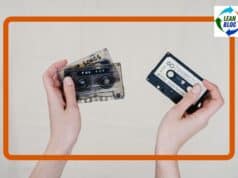 For a little over two years, my wife and I have had a single cup coffee maker, one of those systems that makes an individual cup of coffee (or tea, the real reason we bought it initially) at a time.
For a little over two years, my wife and I have had a single cup coffee maker, one of those systems that makes an individual cup of coffee (or tea, the real reason we bought it initially) at a time.
I am a real amazon.com power user… they are my “single source” supplier as often as practical. I have almost always ordered my replacement pods through Amazon — fast, consistent delivery and shipping through their frequent customer program.
I recently discovered and took advantage of a “Subscribe & Save” service that they offer. If you're willing to sign up for a frequency of your choice, they ship automatically and give you a 15% discount each time (with no cancellation fees). Not a bad deal as a customer.
Now this isn't a “kanban” system really. This *is* a planned, scheduled “push” from amazon to my house. This is sometimes referred to, especially in hospitals, as a “standing order” system.
My previous set up, where I initiated the order, was a true “pull” — when inventory got down to a certain level, I'd log in and place a “one click” order. Pretty easy, with no need for a “subscription.” I was using a “re-order point” pull system previously.
A standing order system can work if you have very steady and predictable use of an item. The risk with standing orders is that if your usage is high, you'll run out before more is sent. Or, if usage is low, you'll end up with excess inventory. At least here, with the coffee pods, inventory is small and relatively cheap. I'll err on the side of ordering more frequently than I really need to.
The Amazon website even told me that I last ordered the pods on February 8th. So, a little over two months. I set up a two month subscription frequency. If inventory is ever piling up, I'll just cancel or change the shipment frequency.
So why would I set up a push system? You'd think I'd be a “lean purist” and only want a pull system. Well, the 15% discount is an incentive to allow that push. And the downside risk is pretty low. I figured it was worth it to at least experiment with system.
What about you? Do any of you subscription type services that automatically deliver a quantity of something to your house? It's sort of like the old “milk man” type service, right? But today, we “pull” milk from the grocery store.
Some other issues that we could explore on this this topic:
- Which has more waste — me driving to a store to buy these (or combining the purchase with a broader grocery trip) or taking advantage of the efficiencies of the UPS delivery network?
- What about the environmental impact of these small plastic coffee pods? At least I am countering that by brewing into a reusable travel mug, which helps cut down on the paper waste at a Starbucks store… of course I could take my travel mug to Starbucks (and they give you a discount for doing that even).
Updated: A few of you asked what single cup brewer I use. We love our Keurig for making both coffee AND tea. It's very fast and convenient in the morning before your commute or any time you don't feel like a full pot of coffee.
Please scroll down (or click) to post a comment. Connect with me on LinkedIn.
Let’s build a culture of continuous improvement and psychological safety—together. If you're a leader aiming for lasting change (not just more projects), I help organizations:
- Engage people at all levels in sustainable improvement
- Shift from fear of mistakes to learning from them
- Apply Lean thinking in practical, people-centered ways
Interested in coaching or a keynote talk? Let’s talk.
Join me for a Lean Healthcare Accelerator Trip to Japan! Learn More










your link is broken, whats a “k-cupes”
How far away from the store do you live? Do you have to go there anwyays to buy other groceries? and what is their pricing compared to amazon’s?
Er also what bout freshness :)
Sorry, I fixed the link and added a picture, I meant “k-cup,” a single serving disposable coffee filter pod that’s used with Keurig single cup coffee makers.
“How far away from the store do you live? Do you have to go there anwyays to buy other groceries? and what is their pricing compared to amazon’s?”
I live maybe 1.5 miles from a major grocery store and, yes, I already make trips there. They don’t sell k-cups.
As for freshness, you’re right that the k-cups aren’t super fresh (ironic, since I’ve criticized Starbucks as you read about recently). It’s all about tradeoffs.
Fast single cup for 40 cents (no overproduction) — k-cup.
Full pot of decent coffee — Starbucks (or other store bought beans) that I grind fresh.
Best pot of great coffee — fresh ground beans that I roasted at home from “green” coffee beans. I don’t always have time for that version of the supply chain.
Mark,
In using your K-cup machine, you are supporting some of your blog readers in Vermont at Green Mountain Coffee Roasters, who owns Keurig.
They offer a factory-direct service called Cafe Express, similar to Amazon.
This might solve your freshness issue…I think the folks at GMCR have pretty strict freshness rules as far as delivery goes. Those rules go out the window at a place like Amazon, which may have them piled to the ceiling for all you know (is there a date code on the cup?).
Also maybe some more flavors to choose from, and I think most of the Green Mountain K-cups are made here in Vermont (don’t know about other brands).
I’ve been to GMCR a couple times, and I’d say they run a tight ship. If I was a coffee drinker (never touch the stuff), I’d buy from them for sure. It’s really high quality coffee, as they say, Crafted With Care…which I have seen first hand.
I just received an advance shipment notification from Amazon, giving me the option of skipping a delivery or changing the terms of my coffee subscription. Nice!
What a nice refreshing view on “push” and “pull”. With the 15% discount you certainly can afford some stockpiling before overrunning the previous “pull”-costs. And thank you for a nice refreshing blog, too.